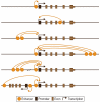Genome-wide principles of gene regulation by the vitamin D receptor and its activating ligand
- PMID: 21664239
- PMCID: PMC3179550
- DOI: 10.1016/j.mce.2011.05.012
Genome-wide principles of gene regulation by the vitamin D receptor and its activating ligand
Abstract
The vitamin D receptor (VDR) mediates virtually all of the known biological actions of the hormonal ligand 1,25-dihydroxyvitamin D(3) (1,25(OH)(2)D(3)). These actions are directed toward the nucleus, where the VDR binds to the regulatory regions of target genes and modulates their transcriptional output. Recent technological advances have enabled the study of transcription factor binding on a genome-wide scale in cells and tissues that are major targets of vitamin D action. In this review, the results of several of these studies are discussed wherein overarching principles of gene regulation by the vitamin D hormone are beginning to emerge. In addition, several specific genes that are regulated by 1,25(OH)(2)D(3) and which provide new insight into the increasingly complex mechanism whereby the receptor functions to modulate gene expression are considered. These studies suggest that while many of the principles that are now accepted regarding the regulation of gene expression by hormones and other regulatory factors are well grounded, others require extensive modification.
Copyright © 2011 Elsevier Ireland Ltd. All rights reserved.
Figures




References
-
- Aguilera O, Peña C, García JM, Larriba MJ, Ordóñez-Morán P, Navarro D, Barbáchano A, López de Silanes I, Ballestar E, Fraga MF, et al. The Wnt antagonist DICKKOPF-1 gene is induced by 1alpha,25-dihydroxyvitamin D3 associated to the differentiation of human colon cancer cells. Carcinogenesis. 2007;28:1877–1884. - PubMed
-
- Bouillon R, Bischoff-Ferrari H, Willett W. Vitamin D and health: perspectives from mice and man. J Bone Miner Res. 2008a;23:974–979. - PubMed
Publication types
MeSH terms
Substances
Grants and funding
LinkOut - more resources
Full Text Sources

